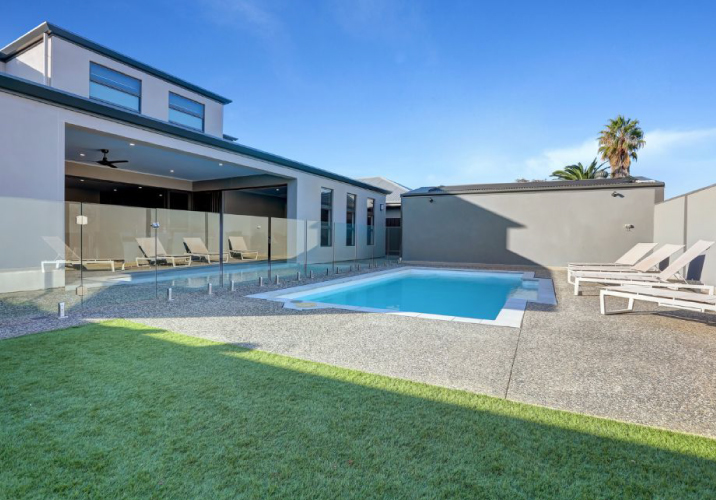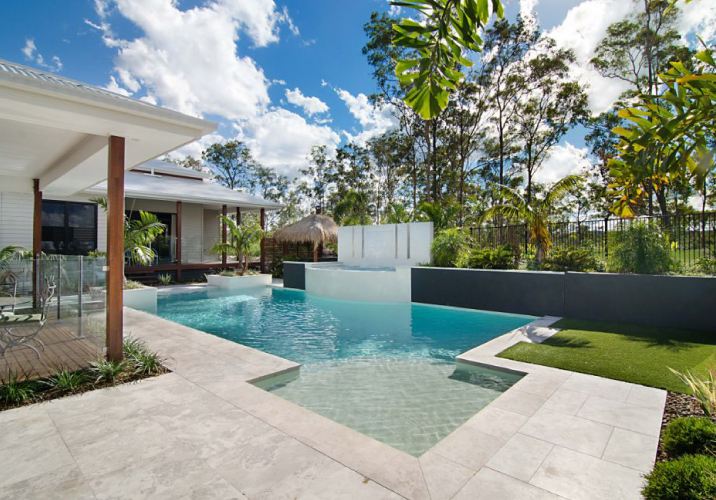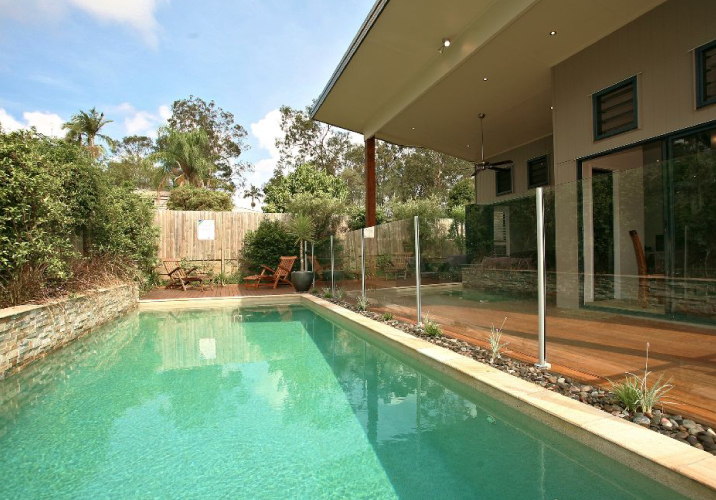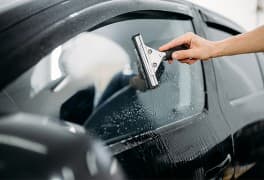
Find a local pool cleaner
- Inspiration /
- Outdoor projects /
- Outdoor living /
- Swimming pool...
Swimming pool maintenance all year round
Keep your pool sparkling from winter to summer
Many pool owners fall into the trap of only paying attention to their pool during summer – when they’re about to go swimming. If you find yourself falling into this category then you’re on a collision course with excessive service and repair bills should you let things go too far.
Pool maintenance is a year-round obligation and doesn’t stop during the off-season. There is plenty to do; from scooping out leaves and debris to balancing your chemicals. So, to help you keep your costs as low as possible, we’ve put together this annual pool maintenance guide that will guide you through every season. Let’s dive into it.
Spring
The secret to a crisp, clean summer-ready swimming pool is opening it up the right way at the end of spring. Start by removing your pool cover and storing it away. If you took proper care of your pool during winter, then there shouldn’t be any nasty surprises lurking underneath such as a green pool.
From here, you get your pool ready for the swimming season in 5 easy steps. We’ve detailed them below.

Connect your hoses and other equipment
This first step won’t apply to the majority of pool owners in Australia, though it’s worth covering for those that live in colder regions. If your neighbourhood often experiences freezing temperatures, then you would have disconnected your filters, pumps and skimmer. If that’s the case, it’s time to hook them back up to your pool.
Top up your pool water
Simple enough, make sure your pool water is about halfway up your skimmer. Topping up your pool water is a great opportunity, however, to check for any leaks. To do this, you can perform a simple test for which all you need is a bucket.
To perform this test, place the bucket on the top step of your pool and fill it most of the way up with water. Then, mark the water levels on the inside and outside of your pool and then leave it for 24 hours.
When you come back, measure the water levels both inside and outside of your bucket. If the water level has dropped only inside your bucket, then there is no cause for concern. Your pool is losing water due to evaporation, and this is normal.
If the water level drops below the marking on the outside of your bucket, this is an indication of a leak. At this stage, you might want to call in a pool servicing professional to have a look.
Break out the vacuum
If you properly closed your pool during winter, then there won’t be much need for this step either. Then again, many pool owners don’t have a cover, making this step another necessity. Grab your leaf skimmer and remove any debris from the surface of your pool. Then, scrub the pool walls and floor before vacuuming away all particles. If you’d rather skip this step, then you should consider investing in a robotic pool cleaner. Then this step will become as simple as pushing a button.
Circulate your pool water
Circulation is among the most important factors when it comes to keeping your pool water sanitary. During the off-season, you typically turn down your pumps to save on electricity bills. During your summer startup though, run your pool pumps for a full 24 hours to ensure it’s properly circulated. This conveniently brings us to the final step.
Test and balance your water
You can test your pool water by breaking out some test strips or scooping out a sample of your pool water and taking it to your local pool shop. For the latter option, measure your pool dimensions so that your local professional will be able to properly advise you on the number of chemicals that you need to use.
Finally, balance your pool based on the advice you receive. Then, test your water one more time to make sure that everything is in order. If everything is in order, your pH levels will be between 7.2 and 7.6.
Summer
Your summer pool maintenance efforts will be an extension of the work you performed during spring. In fact, everything should be pretty routine provided you haven’t bumped into any nasty surprises. All you need to pay attention to is circulating your water, cleaning your pool and balancing your chemicals.
Water circulation
Your pool naturally experiences more use during summer. Therefore, it is only normal that your water should be circulating at a higher rate compared to the offseason. By circulating your water, you will ensure that all dirt and particles make their way to your pool filter where they are collected and kept out of your pool water. As a result, algae build-up and cloudy water will be prevented, both of which can lead to expensive pool cleaning bills.
Replacing a worn-out spider gasket on a multiport valve of a swimming pool filter system is crucial for maintaining a clean and healthy pool. The spider gasket creates a seal between the different ports in the filter system, preventing leaks and maintaining pressure. To replace a spider gasket, first, turn off the pump and drain the filter. Remove the screws that secure the multiport valve and gently remove the valve from the tank. Remove the old spider gasket and clean the area with a cloth. Install the new gasket and carefully reassemble the system, ensuring all connections are tight and secure. It’s recommended to replace the spider gasket every 5 years. Seek professional help if needed.
Cleaning your water
The biggest thing you can do to ensure your pool is looking good is to skim it. You should do this on a daily basis or whenever debris collects. The more you remove through a leaf skimmer, the less bacteria and debris will get into the filtration system. It is also just as important to remove all strainer baskets from the filter area and clean these. You may not need to do these every day, but any time there is material in this area, remove it.
You will also need to vacuum the floor of the pool on a regular basis. There are some devices that are automatic and others that work manually. Automatic devices are ideal because they do the work for you. Be sure to clean out the filter in the vacuum as well.

Chemical balancing
Perhaps the most challenging part of the process is to manage the pH level in the pool. It is ideal for it to be between 7.2 and 7.8. Test regularly with a kit from your local pool store. If the pH is not right, you likely need to add chemicals to balance it. For complete peace of mind, it’s also worth hiring someone qualified for fortnightly or monthly pool maintenance.
Keep the pool covered
To reduce the amount of maintenance you need to do on a regular basis, keep the pool covered when not in use. This helps reduce the amount of evaporation that is taking place as well. It can help to keep your chemicals in the pool and balanced, rather than being removed through exposure to sunlight. Covers also keep debris out.
Maintain the Filter
The filter needs to be cleaned following the manufacturer’s specific instructions. In most cases, you will need to remove it and clean it about once a month or less frequently. If you notice it is not working as efficiently as it was, this is a good indication that you need to clean the filter.
Super chlorinating may be necessary
In many cases, ammonia and nitrogen will build up in your pool. You need to remove these so that they do not interfere with the chlorine you are using in the pool to manage the cleanliness. When you can smell chlorine, this is a good indication that the balance is off. By using a super chlorinating product, you can shock the pool and bring it back to the level it needs to be.
Autumn
Once you’ve had your fun and the swimming season is over, then the next step is to close your pool for winter. Getting your pool winter-ready isn’t tricky at all. In fact, this part of your pool maintenance follows many of the same steps that you performed during your startup.
Clean your pool
Much the same as you would during summer and spring. Remove leaves and debris and then get scrubbing. Brush the walls and the floor of the pool, vacuum the pool, clean the skimmer basket and the pump’s lint basket.
Check your equipment
You want to make sure that your filters and pumps are in working order. Make sure all the oil, grease and scale deposits are out of the pool’s filter. At this stage, you can also wind down your pumps and run them for only 4 hours per day during the whole offseason.
Note: On the off chance that you do live in an area that regularly experiences freezing temperatures then you want to think about disconnecting your equipment as winter approaches.
Balance your pool water
There’s no need for too much detail here – but you’ll want to aim for a PH level between 7.4 and 7.6, . Simply take a sample of your pool water to your local pool shop, and you’ll get all the advice you need. Visiting your local pool shop is also a good opportunity to ask for phosphate remover, though. You might also want to mix in an algaecide to stop algae from coming in.
Put on your pool cover
If you don’t own a pool cover already then get one ASAP. They’re the perfect way to keep debris out during winter, minimize water loss and will also help trap some of the heat in your water.

Winter
The most important part of owning a pool during winter is that you don’t forget to keep an eye on it. There’s not much work involved, and you will only need to peel your pool cover back occasionally to make sure everything is in perfect order.
Clean regularly
Pools that are dormant are an open invitation to all sorts of debris and grime. Cleaning a pool is an activity that takes just a few hours, and it is absolutely crucial to make sure that all the pool equipment such as the skimmers and filters are thoroughly cleaned every fortnight. Frequently cleaning your pool also ensures that algae do not form on the surface of the tiles, which can be hard to get out after a long period of growth.
Cover when not in use
Make use of a pool cover or a pool blanket once you have cleaned the pool. This will prevent leaves, twigs and other debris from accumulating over the surface of the water, making your next pool clean a lot quicker. Remember to remove the pool blanket regularly so that algae does not begin to grow inside the pool.
Check your chemical balance
The chemicals in pool water should be regulated during the winter months when the pool is not in use. Using a water testing kit from your local pool shop, check to see whether the alkalinity and pH of the water are at the appropriate levels around every 6 weeks. Add the needed chemicals to return the water to a state of balance if that is not the case. Another crucial step that must not be forgotten in rebalancing pool chemicals is to run the filter for a period of eight hours so that all the added chemicals are properly mixed through.
Don’t forget the filtration
Running the pool filter in winter helps maintain the balance of pool chemicals and is also essential in ensuring that the water is cleaned and filtered from debris. You can do this by running the filter for three to four hours a day.
How much will your job cost?
The Oneflare Cost Guide Centre is your one-stop shop to help you set your budget; from smaller tasks to larger projects.



